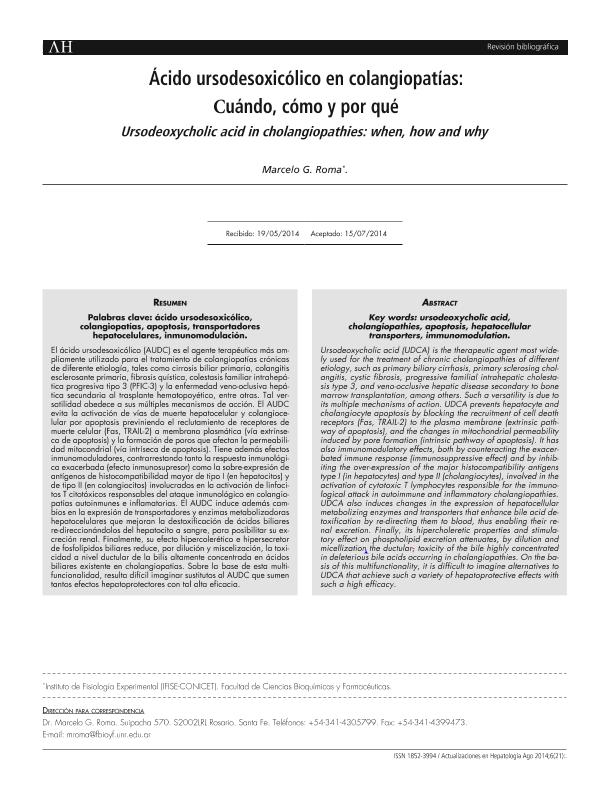Mostrar el registro sencillo del ítem
dc.contributor.author
Roma, Marcelo Gabriel

dc.date.available
2016-06-08T16:44:34Z
dc.date.issued
2014-09
dc.identifier.citation
Roma, Marcelo Gabriel; Ácido ursodesoxicólico en colangiopatías: Cuando, cómo y por qué; ARKHETYPO; Actualizaciones en Hepatología; 6; 21; 9-2014; 19-32
dc.identifier.issn
1852-3994
dc.identifier.uri
http://hdl.handle.net/11336/6117
dc.description.abstract
El ácido ursodesoxicólico (AUDC) es el agente terapéutico más ampliamente utilizado para el tratamiento de colangiopatías crónicas de diferente etiología, tales como cirrosis biliar primaria, colangitis esclerosante primaria, fibrosis quística, colestasis familiar intrahepá- tica progresiva tipo 3 (PFIC-3) y la enfermedad veno-oclusiva hepá- tica secundaria al trasplante hematopoyético, entre otras. Tal versatilidad obedece a sus múltiples mecanismos de acción. El AUDC evita la activación de vías de muerte hepatocelular y colangiocelular por apoptosis previniendo el reclutamiento de receptores de muerte celular (Fas, TRAIL-2) a membrana plasmática (vía extrínseca de apoptosis) y la formación de poros que afectan la permeabilidad mitocondrial (vía intríseca de apoptosis). Tiene además efectos inmunomoduladores, contrarrestando tanto la respuesta inmunológica exacerbada (efecto inmunosupresor) como la sobre-expresión de antígenos de histocompatibilidad mayor de tipo I (en hepatocitos) y de tipo II (en colangiocitos) involucrados en la activación de linfocitos T citotóxicos responsables del ataque inmunológico en colangiopatías autoinmunes e inflamatorias. El AUDC induce además cambios en la expresión de transportadores y enzimas metabolizadoras hepatocelulares que mejoran la destoxificación de ácidos biliares re-direccionándolos del hepatocito a sangre, para posibilitar su excreción renal. Finalmente, su efecto hipercolerético e hipersecretor de fosfolípidos biliares reduce, por dilución y miscelización, la toxicidad a nivel ductular de la bilis altamente concentrada en ácidos biliares existente en cholangiopatias. Sobre la base de esta multifuncionalidad, resulta difícil imaginar sustitutos al AUDC que sumen tantos efectos hepatoprotectores con tal alta eficacia.
dc.description.abstract
Ursodeoxycholic acid (UDCA) is the therapeutic agent most widely used for the treatment of chronic cholangiopathies of different etiology, such as primary biliary cirrhosis, primary sclerosing cholangitis, cystic fibrosis, progressive familial intrahepatic cholestasis type 3, and veno-occlusive hepatic disease secondary to bone marrow transplantation, among others. Such a versatility is due to its multiple mechanisms of action. UDCA prevents hepatocyte and cholangiocyte apoptosis by blocking the recruitment of cell death receptors (Fas, TRAIL-2) to the plasma membrane (extrinsic pathway of apoptosis), and the changes in mitochondrial permeability induced by pore formation (intrinsic pathway of apoptosis). It has also immunomodulatory effects, both by counteracting the exacerbated immune response (immunosuppressive effect) and by inhibiting the over-expression of the major histocompatibility antigens type I (in hepatocytes) and type II (cholangiocytes), involved in the activation of cytotoxic T lymphocytes responsible for the immunological attack in autoimmune and inflammatory cholangiopathies. UDCA also induces changes in the expression of hepatocellular metabolizing enzymes and transporters that enhance bile acid detoxification by re-directing them to blood, thus enabling their renal excretion. Finally, its hipercholeretic properties and stimulatory effect on phospholipid excretion attenuates, by dilution and micellization the ductular, toxicity of the bile highly concentrated in deleterious bile acids occurring in cholangiopathies. On the basis of this multifunctionality, it is difficult to imagine alternatives to UDCA that achieve such a variety of hepatoprotective effects with such a high efficacy.
dc.format
application/pdf
dc.language.iso
spa
dc.publisher
ARKHETYPO
dc.rights
info:eu-repo/semantics/openAccess
dc.rights.uri
https://creativecommons.org/licenses/by-nc-sa/2.5/ar/
dc.subject
Ácido Ursodesoxicólico
dc.subject
Colangiopatías
dc.subject
Colestasis
dc.subject
Mecanismos de Acción
dc.subject.classification
Gastroenterología y Hepatología

dc.subject.classification
Medicina Clínica

dc.subject.classification
CIENCIAS MÉDICAS Y DE LA SALUD

dc.title
Ácido ursodesoxicólico en colangiopatías: Cuando, cómo y por qué
dc.title
Ursodeoxycholic acid in cholangiopathies: when, how and why
dc.type
info:eu-repo/semantics/article
dc.type
info:ar-repo/semantics/artículo
dc.type
info:eu-repo/semantics/publishedVersion
dc.date.updated
2016-06-01T13:47:13Z
dc.journal.volume
6
dc.journal.number
21
dc.journal.pagination
19-32
dc.journal.pais
Argentina

dc.journal.ciudad
Buenos Aires
dc.description.fil
Fil: Roma, Marcelo Gabriel. Consejo Nacional de Investigaciones Científicas y Técnicas. Centro Científico Tecnológico Rosario. Instituto de Fisiología Experimental (i); Argentina
dc.journal.title
Actualizaciones en Hepatología
dc.relation.alternativeid
info:eu-repo/semantics/altIdentifier/url/http://www.arkhetypo.com.ar/revista.php?id=2
Archivos asociados
